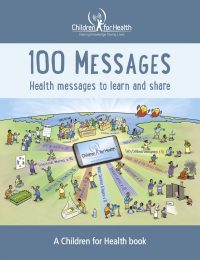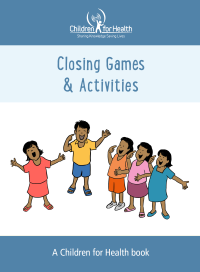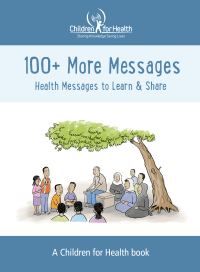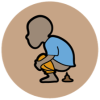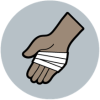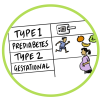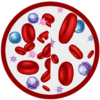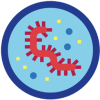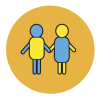Nutrition

Malnutrition and infection impede the physical and mental growth and development of millions of children.
Older children can learn how to prepare for, cook and serve meals to younger siblings. Children can spread awareness about of breastfeeding and its benefits to babies. They can learn about a balanced diet, the importance of sharing food fairly and help to monitor the diet of young children.
Read our Top Ten Messages on Nutrition for children to learn and share. Scroll down to see ideas on what children can do to understand, find out more, take action and reflect on this topic.
Use the links below to browse our FREE resources to help children learn more, share their knowledge and become agents of change.
10 Messages on
Nutrition
- To have a balanced healthy diet, eat different food of different kinds. GO, GROW and GLOW for strong bodies and happy minds!
- Malnutrition means Bad Nutrition and happens if we eat too little, too much or mostly junk food. Avoid malnutrition! Sit and eat enough good food at mealtimes, but not too much.
- To check that babies and young children are growing well watch and help record their lengths and weight at a clinic as often as instructed by a health worker.
- Help avoid lifelong harm to young children. Tell adults to have them checked if you see their arms or body looking thin or their face or feet looking swollen.
- When young children are ill they may not eat well. Give them healthy drinks e.g. breast milk, milk or home-made soup. Also, give extra food when they start to feel better.
- Be a breast milk champion! Breast milk is always fresh and clean and the ONLY food and drink a baby needs from birth to 6 months.
- Help prepare and give older babies good food (6 months to 2 years). They need breast milk plus family food and snacks 3-4 times a day.
- Eat a rainbow of fruits, vegetables including leaves (red, orange, yellow and green). They contain micronutrients too small to see, but vital for our body and mind.
- Wash your hands well using water and a little soap. Rub for 20 seconds, rinse, shake and air-dry after toilet and before preparing food and eating.
- Wash fresh food well as you prepare it. Use cooked food immediately or make sure it’s stored away from flies to make it safe to eat later.
Children can learn, collect & share these messages!
While teaching these messages, encourage children to…
MAKE their own Nutrition Messages using their own words in their own language!
LEARN these messages so they never forget them!
ADD these messages to their collection!
SHARE these messages with other children and their families!
If your class or group is struggling to stay connected and engaged, we have loads of ideas for ideas to help them! Have a look at Closing Games & Activities.
Use the questions/discussion topics below to help children to memorise the messages and really understand them.


What can children make?
DRAW pictures and/or write about the foods they eat each day over a week. They can add colour to the pictures or write colour labels for all food.
WHAT do mothers give their babies to eat as their first food? And after 6 months? How often do they feed their babies? They can record the answers and later make a chart with their friends that show the results.
LEARN which foods are good or bad for babies and young children and why? They can draw pictures of these foods and make a picture chart that showing our results.
What can children do?
LOOK at a growth chart together and ask an adult to explain what all the lines mean.
CHILDREN can ask to attend health clinics and watch while babies and young children are weighed and measured and the data recorded on growth charts.
ASK health workers and others how a growth chart works to check a baby is growing well.
DISCUSS if there are any children they know who are or might be malnourished and what they can do to help.
THEY can ask friends and neighbours to tell them stories about when food caused illness.
CHILDREN can find out from parents, health workers or others how they know if a child is malnourished.
CHILDREN can ask at home and in the community what methods are used to dry or bottle food or other ways to keep food fresh.
CHILDREN can ask other children and people in the community why it’s important to eat naturally colourful food.
IN the market or at home children can find out which vitamin rich foods are available to most people in the community and how these foods are prepared.
AT home, children can observe exactly (and without helping!) how food is prepared, how plates and utensils are washed and dried and when the person preparing the food washes their hands, if they do so properly etc.
ASK family members to tell them about a child they knew who became malnourished and why this happened.
What can children ask?
WHAT do we eat each day/each week? Is it enough? How do we store our food?
HOW many natural colours do we eat each week?
COULD we eat more colourful food?
DOES everyone in our family get enough food to make sure they GROW, GLOW and GO? How do we know?
IS there anyone especially old or especially young that needs someone to notice who much or how little they are eating?
WHAT happened last time someone in the family was ill? What did they eat and drink? What did they eat afterwards? What helped and what didn’t? Find out from a health worker what foods are good for people to eat when they are ill and afterwards.
SOME mothers in your area if they breastfed their babies and the reasons for their choice.
HEATH workers about breastfeeding and the reasons why it is the best choice.
PEOPLE in the community to give their reasons why bottles can be dangerous for the health of a baby.
HEALTH workers how breast milk changes as the baby gets older.
CHILDREN can ask older children, parents and other adults what micronutrients are and what they do.
CHILDREN can ask a health worker or community leader what they think the best foods are for children to eat and why.
CHILDREN can ask their older siblings and others how to tell if food is no longer safe to eat.
Download these free materials now to help children learn and share these
essential health messages. See our free resource section for more!




